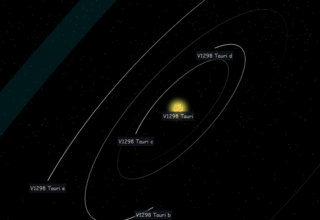Photoevaporation is the process where energetic radiation ionises gas and causes it to disperse away from the ionising source. The term is typically used in an astrophysical context where ultraviolet radiation from hot stars acts on clouds of material such as molecular clouds, protoplanetary disks, or planetary atmospheres.

Hot Jupiters are a class of gas giant exoplanets that are inferred to be physically similar to Jupiter but that have very short orbital periods. The close proximity to their stars and high surface-atmosphere temperatures resulted in their informal name "hot Jupiters".
HD 20782 is the primary of a wide binary system located in the southern constellation Fornax. It has an apparent magnitude of 7.38, making it readily visible in binoculars but not to the naked eye. The system is located relatively close at a distance of 117 light-years based on Gaia DR3 parallax measurements, but it is receding with a heliocentric radial velocity of 40.7 km/s. At its current distance, HD 20782's brightness is diminished by 0.12 magnitudes due to interstellar extinction and it has an absolute magnitude of +4.61.

A Super-Earth or super-terran or super-tellurian is a type of exoplanet with a mass higher than Earth, but substantially below those of the Solar System's ice giants, Uranus and Neptune, which are 14.5 and 17.1 times Earth's, respectively. The term "super-Earth" refers only to the mass of the planet, and so does not imply anything about the surface conditions or habitability. The alternative term "gas dwarfs" may be more accurate for those at the higher end of the mass scale, although "mini-Neptunes" is a more common term.
HAT-P-11, also designated GSC 03561-02092 and Kepler-3, is a metal-rich orange dwarf star with a planetary system, 123 light-years away in the constellation Cygnus. This star is notable for its relatively large rate of proper motion. The apparent magnitude of this star is about 9.6, which means it is not visible to the naked eye but can be seen with a medium-sized amateur telescope on a clear dark night. The age of this star is about 6.5 billion years.

A Mini-Neptune is a planet less massive than Neptune but resembling Neptune in that it has a thick hydrogen-helium atmosphere, probably with deep layers of ice, rock or liquid oceans.

Kepler-69 is a G-type main-sequence star similar to the Sun in the constellation Cygnus, located about 2,390 ly (730 pc) from Earth. On April 18, 2013 it was announced that the star has two planets. Although initial estimates indicated that the terrestrial planet Kepler-69c might be within the star's habitable zone, further analysis showed that the planet very likely is interior to the habitable zone and is far more analogous to Venus than to Earth and thus completely inhospitable.
K2-3, also known as EPIC 201367065, is a red dwarf star with three known planets. It is on the borderline of being a late orange dwarf/K-type star, but because of its temperature, it is classified as a red dwarf.

GJ 3470 b is an exoplanet orbiting the star GJ 3470, located in the constellation Cancer. With a mass of just under 14 Earth-masses, a radius approximately 4.3 times that of Earth's, and a high equilibrium temperature of 615 K, it is a hot Neptune.

A super-Neptune is a planet that is more massive than the planet Neptune. These planets are generally described as being around 5–7 times as large as Earth with estimated masses of 20–80 ME; beyond this they are generally referred to as gas giants. A planet falling within this mass range may also be referred to as a sub-Saturn.
Kepler-51 is a Sun-like star that is about 500 million years old. It is orbited by four planets—Kepler-51b, c, d and e—first three of which are super-puffs and have the lowest known densities of any known exoplanet. The transiting planets in the system are similar in radius to gas giants like Jupiter, but have unusually small masses for their size, only a few times greater than Earth’s.

V1298 Tauri is a young weakly-lined T Tauri star that is part of the Taurus-Auriga association in the Taurus Molecular Cloud. Alternatively it is part of a proposed moving group, called Group 29 that is slightly older. The system has four transiting exoplanets, discovered with the Kepler space telescope in the K2 mission. One of the planets was discovered in August 2019 and the other three were discovered in November 2019 by the same team.

Kepler-1638 is a G-type main-sequence star located about 5,000 light years away in the constellation of Cygnus. One known exoplanet has been found orbiting the star: Kepler-1638b.As of January 2021, Kepler-1638 is the farthest star with a known exoplanet orbiting in the habitable zone.

K2-18b, also known as EPIC 201912552 b, is an exoplanet orbiting the red dwarf K2-18, located 124 light-years (38 pc) away from Earth. The planet is a sub-Neptune about 2.6 times the radius of Earth, with a 33-day orbit within the star's habitable zone. This means it receives about a similar amount of starlight as the Earth receives from the Sun. Initially discovered with the Kepler space telescope, it was later observed by the James Webb Space Telescope (JWST) in order to study the planet's atmosphere.










